Publications
My research focuses on human-computer interaction, in particular on virtual and augmented reality. You can find an overview of my research on Google Scholar and DBLP. My ORCID is 0000-0002-5072-8775.2025

Valentin Schwind, Netsanet Zelalem Tadesse, Estefania Silva da Cunha, Yeganeh Hamidi, Soltan Sanjar Sultani, Jessica Sehrt
A Scoping Review of Informed Consent Practices in Human-Computer Interaction Research Journal Article
In: ACM Trans. Comput.-Hum. Interact., 2025, ISSN: 1073-0516.
@article{Schwind2025,
title = {A Scoping Review of Informed Consent Practices in Human-Computer Interaction Research},
author = {Valentin Schwind and Netsanet Zelalem Tadesse and Estefania Silva da Cunha and Yeganeh Hamidi and Soltan Sanjar Sultani and Jessica Sehrt},
url = {https://vali.de/wp-content/uploads/2025/03/TOCHI_24__Literature_Review_on_Obtaining_Informed_Consent_Practices_in_HCI__Final_Version_-1.pdf},
doi = {10.1145/3721284},
issn = {1073-0516},
year = {2025},
date = {2025-03-03},
urldate = {2025-03-03},
journal = {ACM Trans. Comput.-Hum. Interact.},
publisher = {Association for Computing Machinery},
keywords = {},
pubstate = {published},
tppubtype = {article}
}

Daniel Leichinger, Valentin Schwind, Niels Henze, Martin Kocur
Effects of Embodying Emotional Avatars on Thermophysiological Responses and Affective State in Virtual Reality Proceedings Article
In: Proceedings of the 31st ACM Symposium on Virtual Reality Software and Technology (VRST '25), pp. 1–12, ACM, Montreal, QC, Canada, 2025, ISBN: 979-8-4007-2118-2/25/11.
@inproceedings{Leichinger2025EffectsEmotionalAvatars,
title = {Effects of Embodying Emotional Avatars on Thermophysiological Responses and Affective State in Virtual Reality},
author = {Daniel Leichinger and Valentin Schwind and Niels Henze and Martin Kocur},
url = {https://vali.de/wp-content/uploads/2025/11/vrst25-1.pdf},
doi = {10.1145/3756884.3765966},
isbn = {979-8-4007-2118-2/25/11},
year = {2025},
date = {2025-01-01},
urldate = {2025-01-01},
booktitle = {Proceedings of the 31st ACM Symposium on Virtual Reality Software and Technology (VRST \'25)},
pages = {1\textendash12},
publisher = {ACM},
address = {Montreal, QC, Canada},
keywords = {},
pubstate = {published},
tppubtype = {inproceedings}
}

Stefan Resch, Jean-Gabriel Hanania, Daniel Schor, Esrom Johannes, Benedikt-Josip Kovac, Valentin Schwind, Diana Völz, Daniel Sanchez-Morillo
Foot Placement Feedback in Physical Training: Effects of Spatial User Interfaces on Performance and Workload in Virtual Reality Proceedings Article
In: Proceedings of the 2025 ACM Symposium on Spatial User Interaction, Association for Computing Machinery, New York, NY, USA, 2025, ISBN: 9798400712593.
@inproceedings{10.1145/3694907.3765929,
title = {Foot Placement Feedback in Physical Training: Effects of Spatial User Interfaces on Performance and Workload in Virtual Reality},
author = {Stefan Resch and Jean-Gabriel Hanania and Daniel Schor and Esrom Johannes and Benedikt-Josip Kovac and Valentin Schwind and Diana V\"{o}lz and Daniel Sanchez-Morillo},
url = {https://doi.org/10.1145/3694907.3765929
https://vali.de/wp-content/uploads/2025/11/3694907.3765929.pdf},
doi = {10.1145/3694907.3765929},
isbn = {9798400712593},
year = {2025},
date = {2025-01-01},
urldate = {2025-01-01},
booktitle = {Proceedings of the 2025 ACM Symposium on Spatial User Interaction},
publisher = {Association for Computing Machinery},
address = {New York, NY, USA},
series = {SUI \'25},
abstract = {Agility ladder training is commonly used in fitness and therapy to improve coordination in lower-limb exercises by training precise foot placement. Previous research adapted this training approach to immersive environments and emphasized both the potential and the need for enhanced visual feedback in virtual reality (VR) to improve training outcomes. However, effective visual guidance for such tasks in VR remains underexplored, as it is unclear how spatial user interfaces (UIs) should be designed to support accurate foot placement. To address this gap, we conducted a within-subject study with 40 participants, investigating the effects of two visualization techniques: a Foot-Aligned UI (exocentric, attached to the feet) and a Head-Aligned UI (egocentric, floating in view); combined with color-coded performance feedback. Foot positioning accuracy, rotational control, success rate, and perceived workload were measured during VR-based agility ladder tasks. Results show that the Foot-Aligned UI significantly improved foot placement success rates without increasing cognitive load, compared to the Head-Aligned UI and No UI conditions, which was supported by qualitative feedback. In contrast, color-coded step feedback was perceived as helpful but showed no measurable performance benefit. Based on these findings, we derive design recommendations for spatial UIs to support lower-limb motor training in VR.},
keywords = {},
pubstate = {published},
tppubtype = {inproceedings}
}

Stefan Resch, Jakob Schauer, Valentin Schwind, Diana Völz, Daniel Sanchez-Morillo
Improving Social Acceptance of Orthopedic Foot Orthoses Through Image-Generative AI in Product Design Journal Article
In: Applied Sciences, vol. 15, no. 8, 2025, ISSN: 2076-3417.
@article{app15084132,
title = {Improving Social Acceptance of Orthopedic Foot Orthoses Through Image-Generative AI in Product Design},
author = {Stefan Resch and Jakob Schauer and Valentin Schwind and Diana V\"{o}lz and Daniel Sanchez-Morillo},
url = {https://www.mdpi.com/2076-3417/15/8/4132
https://vali.de/wp-content/uploads/2025/04/applsci-15-04132-v2.pdf},
doi = {10.3390/app15084132},
issn = {2076-3417},
year = {2025},
date = {2025-01-01},
urldate = {2025-01-01},
journal = {Applied Sciences},
volume = {15},
number = {8},
abstract = {The lack of social acceptability for wearable devices such as orthopedic foot orthoses can lead to irregular usage and missed health benefits, as shown in prior studies. While AI-generated designs have been explored for prototyping aesthetic hand orthoses, their impact on social acceptability, particularly for foot orthoses, remains unknown. The current state of research is limited, as no empirical evidence exists on whether AI-designed orthoses influence acceptance, nor has the role of customized generative pre-trained transformers (GPTs) and specific prompting strategies been examined in this context. To address these gaps, we conducted two mixed-methods studies to investigate (1) the impact of AI-generated orthosis designs on social acceptability compared to existing orthopedic products and development concepts and (2) how a customized GPT and different prompt keywords influence acceptance. Our results show that AI-generated designs significantly enhance social acceptance across orthotic categories. Furthermore, we found that personalized GPTs and targeted prompt keywords significantly influence user perception. Overall, our findings highlight the potential of using AI to create socially acceptable design solutions for wearable technology and offer new applications for future smart devices. We contribute to generative AI in product design and provide concrete recommendations for optimizing prompting strategies to enhance social acceptance.},
keywords = {},
pubstate = {published},
tppubtype = {article}
}

Martin Kocur, Melanie Kloss, Christoph Schaufler, Valentin Schwind, Niels Henze
Investigating the Impact of Customized Avatars and the Proteus Effect during Physical Exercise in Virtual Reality Proceedings Article
In: Proceedings of the 2025 CHI Conference on Human Factors in Computing Systems (CHI ’25), pp. 18, ACM, New York, NY, USA, Yokohama, Japan, 2025, ISBN: 979-8-4007-1394-1/25/04.
@inproceedings{Kocur2025Apr,
title = {Investigating the Impact of Customized Avatars and the Proteus Effect during Physical Exercise in Virtual Reality},
author = {Martin Kocur and Melanie Kloss and Christoph Schaufler and Valentin Schwind and Niels Henze},
url = {https://vali.de/wp-content/uploads/2025/03/chi25b-sub2948-cam-i16.pdf},
doi = {10.1145/3706598.3713203},
isbn = {979-8-4007-1394-1/25/04},
year = {2025},
date = {2025-04-26},
urldate = {2025-04-26},
booktitle = {Proceedings of the 2025 CHI Conference on Human Factors in Computing Systems (CHI ’25)},
journal = {CHI Conference on Human Factors in Computing Systems (CHI ’25)},
pages = {18},
publisher = {ACM, New York, NY, USA},
address = {Yokohama, Japan},
keywords = {},
pubstate = {published},
tppubtype = {inproceedings}
}

Elisa Valletta, Anna-Lena Babl, Emma Sophie Reichert, Michael Pickl, Valentin Schwind, Martin Kocur, Niels Henze
Sustained Effects of Avatars on Skin Temperature and Thermal Sensation in Virtual Reality Proceedings Article
In: Proceedings of the 24th International Conference on Mobile and Ubiquitous Multimedia (MUM '25), pp. 1–10, ACM, Enna, Italy, 2025, ISBN: 979-8-4007-2015-4/25/12.
@inproceedings{Valletta2025SustainedEffects,
title = {Sustained Effects of Avatars on Skin Temperature and Thermal Sensation in Virtual Reality},
author = {Elisa Valletta and Anna-Lena Babl and Emma Sophie Reichert and Michael Pickl and Valentin Schwind and Martin Kocur and Niels Henze},
url = {https://vali.de/wp-content/uploads/2025/11/mum25-31.pdf},
doi = {10.1145/3771882.3771885},
isbn = {979-8-4007-2015-4/25/12},
year = {2025},
date = {2025-01-01},
urldate = {2025-01-01},
booktitle = {Proceedings of the 24th International Conference on Mobile and Ubiquitous Multimedia (MUM \'25)},
pages = {1\textendash10},
publisher = {ACM},
address = {Enna, Italy},
keywords = {},
pubstate = {published},
tppubtype = {inproceedings}
}

Stefan Resch, Jean-Gabriel Hanania, Valentin Schwind, Diana Völz, Daniel Sanchez-Morillo
The Influence of Augmented and Virtual Reality Environments on Foot Positioning Success and Workload in Agility Ladder Exercises Proceedings Article
In: 2025 IEEE Conference on Virtual Reality and 3D User Interfaces Abstracts and Workshops (VRW), pp. 679-686, 2025.
@inproceedings{10972792,
title = {The Influence of Augmented and Virtual Reality Environments on Foot Positioning Success and Workload in Agility Ladder Exercises},
author = {Stefan Resch and Jean-Gabriel Hanania and Valentin Schwind and Diana V\"{o}lz and Daniel Sanchez-Morillo},
url = {https://vali.de/wp-content/uploads/2025/08/The_Influence_of_Augmented_and_Virtual_Reality_Environments_on_Foot_Positioning_Success_and_Workload_in_Agility_Ladder_Exercises.pdf},
doi = {10.1109/VRW66409.2025.00139},
year = {2025},
date = {2025-01-01},
urldate = {2025-01-01},
booktitle = {2025 IEEE Conference on Virtual Reality and 3D User Interfaces Abstracts and Workshops (VRW)},
pages = {679-686},
keywords = {},
pubstate = {published},
tppubtype = {inproceedings}
}
2024

Jessica Sehrt, Mustafa Rafati, Cynthia Cheema, Daniel Garofano, Dayana Hristova, Elias Jäger, Valentin Schwind
Auto-REBA: Improving Postural Ergonomics Using an Automatic Real-Time REBA Score in Virtual Reality Journal Article
In: Official Journal of the International Society for Gerontechnology, vol. 23, iss. 2, pp. 1-1, 2024, ISSN: 1569-1101.
@article{Sehrt2024AutoREBA,
title = {Auto-REBA: Improving Postural Ergonomics Using an Automatic Real-Time REBA Score in Virtual Reality},
author = {Jessica Sehrt, Mustafa Rafati, Cynthia Cheema, Daniel Garofano, Dayana Hristova, Elias J\"{a}ger, Valentin Schwind},
url = {https://doi.org/10.4017/gt.2024.23.s.989.opp
https://vali.de/wp-content/uploads/2024/11/Sehrt2024AutoREBA.pdf},
doi = {10.4017/gt.2024.23.s.989.opp},
issn = {1569-1101},
year = {2024},
date = {2024-09-02},
urldate = {2024-09-02},
journal = {Official Journal of the International Society for Gerontechnology},
volume = {23},
issue = {2},
pages = {1-1},
abstract = {This pilot system explores the integration of advanced technologies, including Virtual Reality (VR) and wearable devices, with the REBA (Rapid Entire Body Assessment) (Hignett \& McAtamney, 2000) technique for real-time posture correction and ergonomic assessment. Aimed at mitigating musculoskeletal strain and enhancing ergonomic practices, the research investigates the effectiveness of immediate feedback mechanisms in dynamic and simulated work environments. The ultimate goal is to enable elderly individuals to remain in the workplace longer (Escorpizo, 2008).},
keywords = {},
pubstate = {published},
tppubtype = {article}
}

Jessica Sehrt, Ugur Yilmaz, Thomas Kosch, Valentin Schwind
Closing the Loop: The Effects of Biofeedback Awareness on Physiological Stress Response Using Electrodermal Activity in Virtual Reality Proceedings Article
In: Extended Abstracts of the CHI Conference on Human Factors in Computing Systems, ACM, Honolulu, HI, USA, 2024, ISBN: 979-8-4007-0331-7/24/05.
@inproceedings{sehrt2024closingtheloop,
title = {Closing the Loop: The Effects of Biofeedback Awareness on Physiological Stress Response Using Electrodermal Activity in Virtual Reality},
author = {Jessica Sehrt and Ugur Yilmaz and Thomas Kosch and Valentin Schwind},
url = {https://vali.de/wp-content/uploads/2024/03/chiea24-360.pdf},
doi = {10.1145/3613905.3650830},
isbn = {979-8-4007-0331-7/24/05},
year = {2024},
date = {2024-01-01},
urldate = {2024-01-01},
booktitle = {Extended Abstracts of the CHI Conference on Human Factors in Computing Systems},
publisher = {ACM},
address = {Honolulu, HI, USA},
series = {CHI EA\'24},
keywords = {},
pubstate = {published},
tppubtype = {inproceedings}
}

Jessica Sehrt, Ebony Mbamara, Mustafa Rafati, Valentin Schwind
From Skepticism to Acceptance: A Qualitative Study on the Dynamics of Elderly Engagement with Mixed Reality Proceedings Article
In: Proceedings of Mensch und Computer 2024, pp. 16, ACM, Karlsruhe, Germany, 2024.
@inproceedings{Sehr2024elderly,
title = {From Skepticism to Acceptance: A Qualitative Study on the Dynamics of Elderly Engagement with Mixed Reality},
author = {Jessica Sehrt and Ebony Mbamara and Mustafa Rafati and Valentin Schwind},
url = {https://vali.de/wp-content/uploads/2024/08/muc24a-sub3609-cam-i19.pdf},
doi = {10.1145/3670653.3670666},
year = {2024},
date = {2024-09-01},
urldate = {2024-09-01},
booktitle = {Proceedings of Mensch und Computer 2024},
pages = {16},
publisher = {ACM},
address = {Karlsruhe, Germany},
series = {MuC ’24},
keywords = {},
pubstate = {published},
tppubtype = {inproceedings}
}

Jessica Sehrt, Leonardo Ferreira, Karsten Weyers, Amir Mahmood, Thomas Kosch, Valentin Schwind
Improving Electromyographic Muscle Response Times through Visual and Tactile Prior Stimulation in Virtual Reality Proceedings Article
In: Proceedings of the 2024 CHI Conference on Human Factors in Computing Systems, ACM, Honolulu, HI, USA, 2024, ISBN: 979-8-4007-0330-0/24/05.
@inproceedings{sehrt2024improving,
title = {Improving Electromyographic Muscle Response Times through Visual and Tactile Prior Stimulation in Virtual Reality},
author = {Jessica Sehrt and Leonardo Ferreira and Karsten Weyers and Amir Mahmood and Thomas Kosch and Valentin Schwind},
url = {https://vali.de/wp-content/uploads/2024/02/chi24-202.pdf},
doi = {10.1145/3613904.36420},
isbn = {979-8-4007-0330-0/24/05},
year = {2024},
date = {2024-01-01},
urldate = {2024-01-01},
booktitle = {Proceedings of the 2024 CHI Conference on Human Factors in Computing Systems},
publisher = {ACM},
address = {Honolulu, HI, USA},
series = {CHI \'24},
keywords = {},
pubstate = {published},
tppubtype = {inproceedings}
}

Leon O. H. Kroczek, Angelika Lingnau, Valentin Schwind, Christian Wolff, Andreas Mühlberger
Observers predict actions from facial emotional expressions during real-time social interactions Journal Article
In: Behavioural Brain Research, vol. 471, pp. 115126, 2024, ISSN: 0166-4328.
@article{KROCZEK2024115126,
title = {Observers predict actions from facial emotional expressions during real-time social interactions},
author = {Leon O. H. Kroczek and Angelika Lingnau and Valentin Schwind and Christian Wolff and Andreas M\"{u}hlberger},
url = {https://www.sciencedirect.com/science/article/pii/S0166432824002821
https://vali.de/wp-content/uploads/2024/07/2024-Kroczek-BrainResearch2.pdf},
doi = {https://doi.org/10.1016/j.bbr.2024.115126},
issn = {0166-4328},
year = {2024},
date = {2024-01-01},
urldate = {2024-01-01},
journal = {Behavioural Brain Research},
volume = {471},
pages = {115126},
abstract = {In face-to-face social interactions, emotional expressions provide insights into the mental state of an interactive partner. This information can be crucial to infer action intentions and react towards another person’s actions. Here we investigate how facial emotional expressions impact subjective experience and physiological and behavioral responses to social actions during real-time interactions. Thirty-two participants interacted with virtual agents while fully immersed in Virtual Reality. Agents displayed an angry or happy facial expression before they directed an appetitive (fist bump) or aversive (punch) social action towards the participant. Participants responded to these actions, either by reciprocating the fist bump or by defending the punch. For all interactions, subjective experience was measured using ratings. In addition, physiological responses (electrodermal activity, electrocardiogram) and participants’ response times were recorded. Aversive actions were judged to be more arousing and less pleasant relative to appetitive actions. In addition, angry expressions increased heart rate relative to happy expressions. Crucially, interaction effects between facial emotional expression and action were observed. Angry expressions reduced pleasantness stronger for appetitive compared to aversive actions. Furthermore, skin conductance responses to aversive actions were increased for happy compared to angry expressions and reaction times were faster to aversive compared to appetitive actions when agents showed an angry expression. These results indicate that observers used facial emotional expression to generate expectations for particular actions. Consequently, the present study demonstrates that observers integrate information from facial emotional expressions with actions during social interactions.},
keywords = {},
pubstate = {published},
tppubtype = {article}
}

Martin Kocur, Thomas Noack, Valentin Schwind, Johanna Bogon, Niels Henze
Physiological and Perceptual Effects of Avatars’ Muscularity while Rowing in Virtual Reality Honorable Mention Proceedings Article
In: Proceedings of Mensch und Computer 2024, pp. 9, ACM, Karlsruhe, Germany, 2024.
@inproceedings{Kocur2024rowing,
title = {Physiological and Perceptual Effects of Avatars’ Muscularity while Rowing in Virtual Reality},
author = {Martin Kocur and Thomas Noack and Valentin Schwind and Johanna Bogon and Niels Henze},
url = {https://vali.de/wp-content/uploads/2024/08/muc24a-sub9861-cam-i19.pdf},
doi = {10.1145/3670653.3670654},
year = {2024},
date = {2024-09-01},
urldate = {2024-09-01},
booktitle = {Proceedings of Mensch und Computer 2024},
pages = {9},
publisher = {ACM},
address = {Karlsruhe, Germany},
series = {MuC ’24},
keywords = {},
pubstate = {published},
tppubtype = {inproceedings}
}

Stefan Resch, Rohan Brijesh Tiwari, Heer Rakeshkumar Vankawala, Pyria Singh, Mustafa Rafati, Valentin Schwind, Diana Völz, Daniel Sanchez-Morillo
The Impact of Visual Feedback and Avatar Presence on Balance in Virtual Reality Proceedings Article
In: Proceedings of Mensch und Computer 2024, pp. 5, ACM, Karlsruhe, Germany, 2024.
@inproceedings{Resch2024balancing,
title = {The Impact of Visual Feedback and Avatar Presence on Balance in Virtual Reality},
author = {Stefan Resch and Rohan Brijesh Tiwari and Heer Rakeshkumar Vankawala and Pyria Singh and Mustafa Rafati and Valentin Schwind and Diana V\"{o}lz and Daniel Sanchez-Morillo},
url = {https://vali.de/wp-content/uploads/2024/08/muc24-31-1.pdf},
doi = {https://doi.org/10.1145/3670653.3677472},
year = {2024},
date = {2024-09-01},
urldate = {2024-09-01},
booktitle = {Proceedings of Mensch und Computer 2024},
pages = {5},
publisher = {ACM},
address = {Karlsruhe, Germany},
series = {MuC ’24},
howpublished = {Proceedings of Mensch und Computer 2024},
keywords = {},
pubstate = {published},
tppubtype = {inproceedings}
}

Stefan Resch, Lucian Zimmermann, Alexander Kunkel, Dennis Gerstung, Valentin Schwind, Diana Völz, Daniel Sanchez-Morillo
Usability Evaluation of a Mobile Application for Foot Health Monitoring of Smart Insoles: A Mixed Methods Study Proceedings Article
In: 26th International Conference on Mobile Human-Computer Interaction, ACM, Melbourne, VIC, Australia, 2024.
@inproceedings{Resch2024mobileHCI,
title = {Usability Evaluation of a Mobile Application for Foot Health Monitoring of Smart Insoles: A Mixed Methods Study},
author = {Stefan Resch and Lucian Zimmermann and Alexander Kunkel and Dennis Gerstung and Valentin Schwind and Diana V\"{o}lz and Daniel Sanchez-Morillo},
url = {https://vali.de/wp-content/uploads/2024/09/mobilehci24f-sub1481-cam-i24-2.pdf},
doi = {10.1145/3640471.3680233},
year = {2024},
date = {2024-09-30},
urldate = {2024-09-30},
booktitle = {26th International Conference on Mobile Human-Computer Interaction},
publisher = {ACM},
address = {Melbourne, VIC, Australia},
series = {MOBILEHCI Adjunct ’24},
keywords = {},
pubstate = {published},
tppubtype = {inproceedings}
}

Stefan Resch, André Röll, Artus Malech, Valentin Schwind, Daniel Sanchez-Morillo, Diana Völz
Walking Aid with Haptic Feedback for Combined Use with a Smart Foot Orthosis Journal Article
In: Official Journal of the International Society for Gerontechnology, vol. 23, iss. 2, pp. 1-1, 2024, ISSN: 1569-1101.
@article{Resch2024WalkingAid,
title = {Walking Aid with Haptic Feedback for Combined Use with a Smart Foot Orthosis},
author = {Stefan Resch, Andr\'{e} R\"{o}ll, Artus Malech, Valentin Schwind, Daniel Sanchez-Morillo, Diana V\"{o}lz},
url = {https://doi.org/10.4017/gt.2024.23.s.917.pp
https://vali.de/wp-content/uploads/2024/11/Resch2024WalkingAid.pdf},
doi = {10.4017/gt.2024.23.s.917.pp},
issn = {1569-1101},
year = {2024},
date = {2024-09-02},
urldate = {2024-09-02},
journal = {Official Journal of the International Society for Gerontechnology},
volume = {23},
issue = {2},
pages = {1-1},
abstract = {Elderly people often face the risk of falls, which increases the need for walking aids to ensure mobility and safety. The occurrence of further injuries requires the use of additional orthopedic aids (e.g., foot orthoses). Wearing such an orthopedic aid also impairs the natural gait pattern, which leads to increased instability in older patients. This highlights the need for innovative solutions for assistive smart walking aids. Doan et al., for example, presented a smart walking aid for fall detection that can detect falls based on machine learning with an accuracy of 99.62% (Doan et al., 2024). This development can lead to improvements in home care and remote health monitoring technologies. However, a solution that allows the combined use of an intelligent walking aid with a smart foot orthosis to provide patients with active feedback does not exist. Based on the identified research gap, we propose the technical development of an augmented walking aid with haptic feedback that enables direct communication of sensor data with a smart foot orthosis. Providing additional feedback in case of problems with the foot orthosis is particularly important for patients with neuropathy in the feet (such as diabetic foot syndrome), for which neural feedback is not possible. Our approach enables direct haptic feedback through vibrations on the handle of the walking aid when acute problems are detected by the smart foot orthosis. The system achieves this by continuously monitoring relevant gait parameters and pressure distributions in the foot orthosis. This should support the proactive adaptation of gait problems and increase safety when using assistive technologies for older people.},
keywords = {},
pubstate = {published},
tppubtype = {article}
}

Martin Kocur, Alexander Kalus, Valentin Schwind, Niels Henze
Workshop on Ubiquitous Mixed Reality: Unveiling Opportunities and Challenges Workshop
2024.
@workshop{Kocur2024UbiquitousMR,
title = {Workshop on Ubiquitous Mixed Reality: Unveiling Opportunities and Challenges},
author = {Martin Kocur and Alexander Kalus and Valentin Schwind and Niels Henze},
url = {https://vali.de/wp-content/uploads/2024/08/MuC24_WUMR.pdf},
doi = {10.18420/muc2024-mci-ws06-119},
year = {2024},
date = {2024-09-01},
urldate = {2024-09-01},
howpublished = {Mensch und Computer 2024 \textendash Workshopband, Gesellschaft f\"{u}r Informatik e.V.},
keywords = {},
pubstate = {published},
tppubtype = {workshop}
}
2023
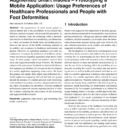
Stefan Resch, Khalid Zoufal, Imad Akhouaji, Mohamed-Amin Abbou, Valentin Schwind, Diana Völz
Augmented Smart Insoles - Prototyping a Mobile Application: Usage Preferences of Healthcare Professionals and People with Foot Deformities Journal Article
In: Current Directions in Biomedical Engineering, vol. 9, no. 1, pp. 698–701, 2023.
@article{Resch2023augmented,
title = {Augmented Smart Insoles - Prototyping a Mobile Application: Usage Preferences of Healthcare Professionals and People with Foot Deformities},
author = {Stefan Resch and Khalid Zoufal and Imad Akhouaji and Mohamed-Amin Abbou and Valentin Schwind and Diana V\"{o}lz},
url = {https://doi.org/10.1515/cdbme-2023-1175},
doi = {doi:10.1515/cdbme-2023-1175},
year = {2023},
date = {2023-01-01},
urldate = {2023-01-01},
journal = {Current Directions in Biomedical Engineering},
volume = {9},
number = {1},
pages = {698\textendash701},
keywords = {},
pubstate = {published},
tppubtype = {article}
}
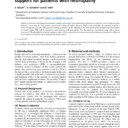
Stefan Resch, Valentin Schwind, Diana Völz
Body position in virtual reality-balancing support for patients with neuropathy Journal Article
In: Proceedings on Automation in Medical Engineering, vol. 2, no. 1, pp. 744–744, 2023.
@article{resch2023body,
title = {Body position in virtual reality-balancing support for patients with neuropathy},
author = {Stefan Resch and Valentin Schwind and Diana V\"{o}lz},
url = {https://vali.de/wp-content/uploads/2023/05/744-Kurzbeitrag.pdf},
year = {2023},
date = {2023-01-01},
urldate = {2023-01-01},
journal = {Proceedings on Automation in Medical Engineering},
volume = {2},
number = {1},
pages = {744--744},
keywords = {},
pubstate = {published},
tppubtype = {article}
}
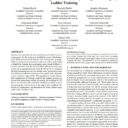
Stefan Resch, Mustafa Rafati, Angela Altomare, Oumaima Raddi, Arso Tahmas, Valentin Schwind, Diana Völz
Correct Foot Positioning in Virtual Reality through Visual Agility Ladder Training Proceedings Article
In: Proceedings of Mensch Und Computer 2023, pp. 524–528, Association for Computing Machinery, Rapperswil, Switzerland, 2023, ISBN: 9798400707711.
@inproceedings{10.1145/3603555.3608558,
title = {Correct Foot Positioning in Virtual Reality through Visual Agility Ladder Training},
author = {Stefan Resch and Mustafa Rafati and Angela Altomare and Oumaima Raddi and Arso Tahmas and Valentin Schwind and Diana V\"{o}lz},
url = {https://doi.org/10.1145/3603555.3608558
https://vali.de/wp-content/uploads/2023/09/3603555.3608558.pdf},
doi = {10.1145/3603555.3608558},
isbn = {9798400707711},
year = {2023},
date = {2023-01-01},
urldate = {2023-01-01},
booktitle = {Proceedings of Mensch Und Computer 2023},
pages = {524\textendash528},
publisher = {Association for Computing Machinery},
address = {Rapperswil, Switzerland},
series = {MuC '23},
abstract = {Incorrect gait patterns and foot positioning can lead to serious consequences for the entire musculoskeletal system of the human body. While previous work indicates that training with an agility ladder in immersive environments such as in virtual reality (VR) is helpful for training foot positioning using visual feedback, it remains unknown how the visual feedback affects the users’ gait pattern. In an experimental user study (N=20) in VR, we compared the foot positioning success rate and the users’ preferences using four different visualization techniques of an agility ladder (footsteps, arrows, numbers, empty fields). The quantitative results indicate that visualization of footsteps achieved the highest accuracy in correct foot positioning without increasing the workload in VR. This is in contrast to the qualitative feedback in which most of the participants were in favor of the empty field condition. We discuss the implications and limitations for future studies using agility ladder training in VR.},
keywords = {},
pubstate = {published},
tppubtype = {inproceedings}
}

Martin Kocur, Lukas Jackermeier, Valentin Schwind, Niels Henze
The Effects of Avatar and Environment on Thermal Perception and Skin Temperature in Virtual Reality Proceedings Article
In: Proceedings of the 2023 CHI Conference on Human Factors in Computing Systems (CHI '23), ACM, 2023.
@inproceedings{Kocur2023,
title = {The Effects of Avatar and Environment on Thermal Perception and Skin Temperature in Virtual Reality},
author = {Martin Kocur and Lukas Jackermeier and Valentin Schwind and Niels Henze},
url = {https://doi.org/10.1145/3544548.3580668
https://vali.de/wp-content/uploads/2023/01/sample-manuscript.pdf},
doi = {10.1145/3544548.3580668},
year = {2023},
date = {2023-04-23},
urldate = {2023-04-23},
booktitle = {Proceedings of the 2023 CHI Conference on Human Factors in Computing Systems (CHI '23)},
volume = {1},
publisher = {ACM},
keywords = {},
pubstate = {published},
tppubtype = {inproceedings}
}

Jessica Sehrt, Tim Wißmann, Jan Breitenbach, Valentin Schwind
The Effects of Body Location and Biosignal Feedback Modality on Performance and Workload Using Electromyography in Virtual Reality Proceedings Article
In: Proceedings of the 2023 CHI Conference on Human Factors in Computing Systems (CHI '23), ACM, 2023.
@inproceedings{SehrtCHI2023,
title = {The Effects of Body Location and Biosignal Feedback Modality on Performance and Workload Using Electromyography in Virtual Reality},
author = {Jessica Sehrt and Tim Wi\ssmann and Jan Breitenbach and Valentin Schwind},
url = {https://doi.org/10.1145/3544548.3580738
https://vali.de/wp-content/uploads/2023/01/chi23-101.pdf},
doi = {10.1145/3544548.3580738},
year = {2023},
date = {2023-04-23},
urldate = {2023-04-23},
booktitle = {Proceedings of the 2023 CHI Conference on Human Factors in Computing Systems (CHI '23)},
publisher = {ACM},
keywords = {},
pubstate = {published},
tppubtype = {inproceedings}
}
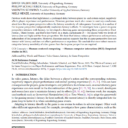
David Halbhuber, Philipp Schauhuber, Valentin Schwind, Niels Henze
The Effects of Latency and In-Game Perspective on Player Performance and Game Experience Journal Article
In: Proc. ACM Hum.-Comput. Interact., vol. 7, no. CHI PLAY, 2023.
@article{Halbhuber2023c,
title = {The Effects of Latency and In-Game Perspective on Player Performance and Game Experience},
author = {David Halbhuber and Philipp Schauhuber and Valentin Schwind and Niels Henze},
url = {https://doi.org/10.1145/3611070
https://vali.de/wp-content/uploads/2023/10/3611070.pdf},
doi = {10.1145/3611070},
year = {2023},
date = {2023-10-01},
urldate = {2023-10-01},
journal = {Proc. ACM Hum.-Comput. Interact.},
volume = {7},
number = {CHI PLAY},
publisher = {Association for Computing Machinery},
address = {New York, NY, USA},
abstract = {Previous work shows that high latency, a prolonged delay between player in- and system output, negatively affects player experience and performance. However, previous work also comes to contrary conclusions about how the in-game perspective alters the latency sensitivity of video games. Currently, it is unclear if the in-game perspective independently modulates latency's effects. To investigate how a game's in-game perspective interacts with latency, we developed a shooting game incorporating three perspectives (First-Person-, Third-Person-, and Bird's-Eye-View). In a study, participants (N = 36) played with two levels of latency (low and high) and the three perspectives. We show that latency reduces performance and experience, independent of the perspective. Moreover, Bayesian analysis suggests that the in-game perspective does not interact with latency and does not affects performance or experience. We conclude that more robust means to categorize latency sensitivity of video games than the in-game perspective are required.},
keywords = {},
pubstate = {published},
tppubtype = {article}
}

Valentin Schwind, Stefan Resch, Jessica Sehrt
The HCI User Studies Toolkit: Supporting Study Designing and Planning for Undergraduates and Novice Researchers in Human-Computer Interaction Proceedings Article
In: Extended Abstracts of the 2023 CHI Conference on Human Factors in Computing Systems (CHI EA '23), ACM, 2023.
@inproceedings{Schwind2023a,
title = {The HCI User Studies Toolkit: Supporting Study Designing and Planning for Undergraduates and Novice Researchers in Human-Computer Interaction},
author = {Valentin Schwind and Stefan Resch and Jessica Sehrt},
url = {https://doi.org/10.1145/3544549.3585890
https://vali.de/wp-content/uploads/2023/03/chiea23-583.pdf},
doi = {10.1145/3544549.3585890},
year = {2023},
date = {2023-04-23},
urldate = {2023-04-23},
booktitle = {Extended Abstracts of the 2023 CHI Conference on Human Factors in Computing Systems (CHI EA '23)},
publisher = {ACM},
keywords = {},
pubstate = {published},
tppubtype = {inproceedings}
}
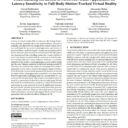
David Halbhuber, Martin Kocur, Alexander Kalus, Kevin Angermeyer, Valentin Schwind, Niels Henze
Understanding the Effects of Perceived Avatar Appearance on Latency Sensitivity in Full-Body Motion-Tracked Virtual Reality Proceedings Article
In: Proceedings of Mensch Und Computer 2023, pp. 1–15, Association for Computing Machinery, Rapperswil, Switzerland, 2023, ISBN: 9798400707711.
@inproceedings{10.1145/3603555.3603580,
title = {Understanding the Effects of Perceived Avatar Appearance on Latency Sensitivity in Full-Body Motion-Tracked Virtual Reality},
author = {David Halbhuber and Martin Kocur and Alexander Kalus and Kevin Angermeyer and Valentin Schwind and Niels Henze},
url = {https://doi.org/10.1145/3603555.3603580
https://vali.de/wp-content/uploads/2023/09/3603555.3603580.pdf},
doi = {10.1145/3603555.3603580},
isbn = {9798400707711},
year = {2023},
date = {2023-01-01},
urldate = {2023-01-01},
booktitle = {Proceedings of Mensch Und Computer 2023},
pages = {1\textendash15},
publisher = {Association for Computing Machinery},
address = {Rapperswil, Switzerland},
series = {MuC '23},
abstract = {Latency in virtual reality (VR) can decrease the feeling of presence and body ownership. How users perceive latency, however, is malleable and affected by the design of the virtual content. Previous work found that an avatar’s visual appearance, particularly its perceived fitness, can be leveraged to change user perception and behavior. Moreover, previous work investigating non-VR video games also demonstrated that controlling avatars that visually conform to users’ expectations associated with the avatars’ perceived characteristics increases the users’ latency tolerance. However, it is currently unknown if the avatar’s visual appearance can be used to modulate the users’ latency sensitivity in full-body motion-tracked VR. Therefore, we conducted two studies to investigate if the avatars’ appearance can be used to decrease the negative impact of latency. In the first study, 41 participants systematically determined two sets of avatars whose visual appearance is perceived to be more or less fit in two physically challenging tasks. In a second study (N = 16), we tested the two previously determined avatars (perceived to be more fit vs. perceived to be less fit) in the two tasks using VR with two levels of controlled latency (system vs. high). We found that embodying an avatar perceived as more fit significantly increases the participants’ physical performance, body ownership, presence, and intrinsic motivation. While we show that latency negatively affects performance, our results also suggest that the avatar’s visual appearance does not alter the effects of latency in VR.},
keywords = {},
pubstate = {published},
tppubtype = {inproceedings}
}
2022

David Halbhuber, Julian Höpfinger, Valentin Schwind, Niels Henze
A Dataset to Investigate First-Person Shooter Players Proceedings Article
In: Extended Abstracts of the 2022 Annual Symposium on Computer-Human Interaction in Play, pp. 51-56, Association for Computing Machinery, Bremen, Germany, 2022, ISBN: 9781450392112.
@inproceedings{halbhuber2022dataset,
title = {A Dataset to Investigate First-Person Shooter Players},
author = {David Halbhuber and Julian H\"{o}pfinger and Valentin Schwind and Niels Henze},
url = {https://doi.org/10.1145/3505270.3558331
https://vali.de/wp-content/uploads/2022/11/3505270.3558331.pdf},
doi = {10.1145/3505270.3558331},
isbn = {9781450392112},
year = {2022},
date = {2022-01-01},
urldate = {2022-01-01},
booktitle = {Extended Abstracts of the 2022 Annual Symposium on Computer-Human Interaction in Play},
pages = {51-56},
publisher = {Association for Computing Machinery},
address = {Bremen, Germany},
series = {CHI PLAY '22},
abstract = {Datasets are multi-purpose research tools, enabling researchers to design, develop, and test solutions to classical computer sciences problems and novel research questions. In the gaming domain, however, there are few high-quality datasets providing both: (1) visual gameplay data and (2) additional information about the gameplay, such as user input. As a result, game researchers most of the time have to collect, process, and annotate gameplay data in time-consuming data collection studies themselves. We start closing this gap, by presenting a novel Counter-Strike: Global Offensive dataset. The contributed dataset is a collection of 12 high-skilled players playing Counter-Strike: Global Offensive. We showcase two deep learning-based examples using the presented dataset, demonstrating its versatility.},
keywords = {},
pubstate = {published},
tppubtype = {inproceedings}
}
Martin Kocur, Jessica Sehrt, Valentin Schwind, Niels Henze
Designing Interactive Avatars for Mixed Reality Applications Journal Article
In: Tutorial at Mensch und Computer 2022 (MuC'22), 2022.
@article{kocur2022designing,
title = {Designing Interactive Avatars for Mixed Reality Applications},
author = {Martin Kocur and Jessica Sehrt and Valentin Schwind and Niels Henze},
url = {https://vali.de/wp-content/uploads/2022/11/MuCTut__Irgendwas_mit_Avataren.pdf},
doi = {10.18420/muc2022-mci-tut03-408},
year = {2022},
date = {2022-09-04},
urldate = {2022-09-04},
journal = {Tutorial at Mensch und Computer 2022 (MuC'22)},
address = {Darmstadt, Germany},
keywords = {},
pubstate = {published},
tppubtype = {article}
}
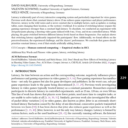
David Halbhuber, Valentin Schwind, Niels Henze
Don’t Break my Flow: Effects of Switching Latency in Shooting Video Games Journal Article
In: Proc. ACM Hum.-Comput. Interact., vol. 6, no. CHI PLAY, pp. 20, 2022.
@article{Halbhuber2022a,
title = {Don’t Break my Flow: Effects of Switching Latency in Shooting Video Games},
author = {David Halbhuber and Valentin Schwind and Niels Henze},
url = {https://doi.org/10.1145/3549492
https://vali.de/wp-content/uploads/2022/08/V6chip229-halbhuber-CC-BY-2.pdf},
doi = {10.1145/3549492},
year = {2022},
date = {2022-10-01},
urldate = {2022-10-01},
journal = {Proc. ACM Hum.-Comput. Interact.},
volume = {6},
number = {CHI PLAY},
pages = {20},
publisher = {ACM},
address = {New York, NY, USA},
organization = {Association for Computing Machinery},
series = {CHI PLAY },
abstract = {Latency is inherently part of every interactive computing system and particularly important for video games. Previous work shows that constant latency above 25 ms reduces game experience and player performance. However, latency in the wild varies and is never constant due to multiple factors, such as updates in routing tables, users changing their location, or the system's workload. It is unclear if switching latency impairs the gaming experience stronger than a constant high latency. To elucidate, we conducted an experiment with 264 participants playing a shooting video game induced with 0 ms, 33 ms, and 66 ms controlled latency. While playing, the game switched between different latency levels based on three frequencies. Our analysis shows that switching latency significantly impaired the participants' flow. Additionally, we found effects on the perceived tension, the experienced challenge, and the players' performance. We conclude that games should prioritize constant latency, even if that entails artificially adding latency.},
keywords = {},
pubstate = {published},
tppubtype = {article}
}
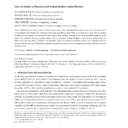
Alexander Kalus, Martin Kocur, Johanna Bogon, Niels Henze, Valentin Schwind
How to Induce a Physical and Virtual Rubber Hand Illusion Miscellaneous
Mensch und Computer 2022 (MuC ’22), 2022.
@misc{Kalus2022a,
title = {How to Induce a Physical and Virtual Rubber Hand Illusion},
author = {Alexander Kalus and Martin Kocur and Johanna Bogon and Niels Henze and Valentin Schwind},
url = {https://vali.de/wp-content/uploads/2022/09/muc22-31-2.pdf},
doi = {10.1145/3543758.3547512},
year = {2022},
date = {2022-09-04},
urldate = {2022-09-04},
abstract = {Understanding body ownership is essential when creating virtual reality (VR) applications using avatars. One of the most widelyused paradigm to investigate body ownership is the rubber hand illusion (RHI). When a real hand and a rubber hand are stroked synchronously, participants can experience the rubber hand as their own hand. Although the knowledge from RHI experiments in the real world is applied to when users embody avatars in VR, it is still unclear whether the illusory ownership of a virtual and physical body produces the same effects. In addition, conducting RHI studies in VR would allow gaining a range of novel experiments that are not possible in the real world. With this demonstration, we therefore present a system and approach to investigate the RHI in the real world and in VR.},
howpublished = {Mensch und Computer 2022 (MuC ’22)},
keywords = {},
pubstate = {published},
tppubtype = {misc}
}

Leon O H Kroczek, Angelika Lingnau, Valentin Schwind, Christian Wolff, Andreas Mühlberger
Observers predict actions from facial emotional expressions during real-time social interactions Journal Article
In: 2022.
@article{kroczek2022observers,
title = {Observers predict actions from facial emotional expressions during real-time social interactions},
author = {Leon O H Kroczek and Angelika Lingnau and Valentin Schwind and Christian Wolff and Andreas M\"{u}hlberger},
url = {psyarxiv.com/fzcau
https://vali.de/wp-content/uploads/2022/11/Emotion_Action_VR_preprint.pdf},
doi = {10.31234/osf.io/fzcau},
year = {2022},
date = {2022-02-01},
urldate = {2022-02-01},
publisher = {PsyArXiv},
keywords = {},
pubstate = {published},
tppubtype = {article}
}
Maximiliane Windl, Anna-Marie Ortloff, Niels Henze, Valentin Schwind
Privacy at a Glance: A Process to Learn Modular Privacy Icons During Web Browsing Proceedings Article
In: ACM SIGIR Conference on Human Information Interaction and Retrieval, pp. 102–112, Association for Computing Machinery, Regensburg, Germany, 2022, ISBN: 9781450391863.
@inproceedings{10.1145/3498366.3505813,
title = {Privacy at a Glance: A Process to Learn Modular Privacy Icons During Web Browsing},
author = {Maximiliane Windl and Anna-Marie Ortloff and Niels Henze and Valentin Schwind},
url = {https://doi.org/10.1145/3498366.3505813
https://vali.de/wp-content/uploads/2022/03/2022-CHIIR-PrivacyIcons.pdf},
doi = {10.1145/3498366.3505813},
isbn = {9781450391863},
year = {2022},
date = {2022-01-01},
urldate = {2022-01-01},
booktitle = {ACM SIGIR Conference on Human Information Interaction and Retrieval},
pages = {102\textendash112},
publisher = {Association for Computing Machinery},
address = {Regensburg, Germany},
series = {CHIIR '22},
abstract = {Privacy policies (PPs) are currently the only way to inform users about their rights and choices during web browsing and searching. However, users avoid engaging with them, because of their length and abstract legal language, which makes them hard to read and understand. We propose to support the understanding of PPs by using modular icons. Icons have already proven to be helpful in visualizing concepts with high information density. However, the value of using icons to supplement PPs lacks a scientific foundation. Thus, we conducted two studies to evaluate existing icon sets for their understandability and to teach participants their meaning in situ. We show that modular privacy icons can be taught using our process, which has the potential to aid quicker and easier comprehension of PPs. We contribute a set of tested modular privacy icons and a verified process on how to teach them to users incidentally during web browsing.},
keywords = {},
pubstate = {published},
tppubtype = {inproceedings}
}
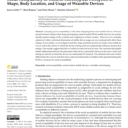
Jessica Sehrt, Bent Braams, Niels Henze, Valentin Schwind
Social Acceptability in Context: Stereotypical Perception of Shape, Body Location, and Usage of Wearable Devices Journal Article
In: Big Data and Cognitive Computing, vol. 6, no. 4, 2022, ISSN: 2504-2289.
@article{Sehrt2022c,
title = {Social Acceptability in Context: Stereotypical Perception of Shape, Body Location, and Usage of Wearable Devices},
author = {Jessica Sehrt and Bent Braams and Niels Henze and Valentin Schwind},
url = {https://www.mdpi.com/2504-2289/6/4/100
https://vali.de/wp-content/uploads/2022/09/BDCC-06-00100.pdf},
doi = {10.3390/bdcc6040100},
issn = {2504-2289},
year = {2022},
date = {2022-01-01},
urldate = {2022-01-01},
journal = {Big Data and Cognitive Computing},
volume = {6},
number = {4},
abstract = {Assessing social acceptability is vital when designing body-worn mobile devices. Previous research found evidence that using stereotyping content model (SCM) mobile devices can systematically predict ratings of the warmth and competence of their wearers. However, it is currently unknown if other contextual dimensions of mobile device usage can also systematically affect those ratings. In two studies, we investigate if and how shape and body location of a body-worn mobile device as well as the activity in which the device is being used can systematically influence stereotypical ratings. Our results suggest that this is evident in some but not all cases. We conclude that people further differentiate between the placement of the device, particularly devices in the user\’s hand, and during an activity in which the device can contextually be misused. This indicates that users further differentiate the context and that more contexual information is helpful while operationalizing the SCM as a measure for social acceptability.},
keywords = {},
pubstate = {published},
tppubtype = {article}
}

Jessica Sehrt, Bent Braams, Niels Henze, Valentin Schwind
Social Acceptability in Context: Stereotypical Perception of Shape, Body Location, and Usage of Wearable Devices Journal Article
In: Big Data Cogn. Comput., vol. 6, no. 4, pp. 100, 2022, ISSN: 2504-2289.
@article{Sehrt2022Sep,
title = {Social Acceptability in Context: Stereotypical Perception of Shape, Body Location, and Usage of Wearable Devices},
author = {Jessica Sehrt and Bent Braams and Niels Henze and Valentin Schwind},
url = {https://vali.de/wp-content/uploads/2024/11/BDCC-06-00100.pdf},
doi = {10.3390/bdcc6040100},
issn = {2504-2289},
year = {2022},
date = {2022-09-01},
urldate = {2022-09-01},
journal = {Big Data Cogn. Comput.},
volume = {6},
number = {4},
pages = {100},
publisher = {Multidisciplinary Digital Publishing Institute},
keywords = {},
pubstate = {published},
tppubtype = {article}
}

Martin Kocur, Johanna Bogon, Manuel Mayer, Miriam Witte, Amelie Karber, Niels Henze, Valentin Schwind
Sweating Avatars Decrease Perceived Exertion and Increase Perceived Endurance While Cycling in Virtual Reality Proceedings Article
In: 28th ACM Symposium on Virtual Reality Software and Technology, Association for Computing Machinery, Tsukuba, Japan, 2022, ISBN: 9781450398893.
@inproceedings{Kocur2022sweating,
title = {Sweating Avatars Decrease Perceived Exertion and Increase Perceived Endurance While Cycling in Virtual Reality},
author = {Martin Kocur and Johanna Bogon and Manuel Mayer and Miriam Witte and Amelie Karber and Niels Henze and Valentin Schwind},
url = {https://doi.org/10.1145/3562939.3565628
https://vali.de/wp-content/uploads/2022/11/2022-VRST-Sweating.pdf},
doi = {10.1145/3562939.3565628},
isbn = {9781450398893},
year = {2022},
date = {2022-01-01},
urldate = {2022-01-01},
booktitle = {28th ACM Symposium on Virtual Reality Software and Technology},
publisher = {Association for Computing Machinery},
address = {Tsukuba, Japan},
series = {VRST '22},
abstract = {Avatars are used to represent users in virtual reality (VR) and create embodied experiences. Previous work showed that avatars’ stereotypical appearance can affect users’ physical performance and perceived exertion while exercising in VR. Although sweating is a natural human response to physical effort, surprisingly little is known about the effects of sweating avatars on users. Therefore, we conducted a study with 24 participants to explore the effects of sweating avatars while cycling in VR. We found that visualizing sweat decreases the perceived exertion and increases perceived endurance. Thus, users feel less exerted while embodying sweating avatars. We conclude that sweating avatars contribute to more effective exergames and fitness applications.},
keywords = {},
pubstate = {published},
tppubtype = {inproceedings}
}
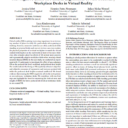
Jessica Sehrt, Henrico Putra Neumann, Julian Niclas Wenzel, Luca Kindermann, Valentin Schwind
The Negative Effect on Postural Ergonomics of Non-Sedentary Workplace Desks in Virtual Reality Proceedings Article
In: Mensch und Computer 2022 (MuC '22), ACM, New York, NY, USA, 2022, ISBN: 978-1-4503-9690-5/22/09.
@inproceedings{Sehrt2022b,
title = {The Negative Effect on Postural Ergonomics of Non-Sedentary Workplace Desks in Virtual Reality},
author = {Jessica Sehrt and Henrico Putra Neumann and Julian Niclas Wenzel and Luca Kindermann and Valentin Schwind},
url = {https://dl.acm.org/doi/10.1145/3543758.3547541
https://vali.de/wp-content/uploads/2022/07/2022-MuC-ErgonomicsInVR.pdf},
doi = {10.1145/3543758.3547541},
isbn = {978-1-4503-9690-5/22/09},
year = {2022},
date = {2022-09-04},
urldate = {2022-09-04},
booktitle = {Mensch und Computer 2022 (MuC '22)},
publisher = {ACM},
address = {New York, NY, USA},
abstract = {Virtual reality (VR) is gaining increasing importance in an increasing number of places in daily life, particularly when gaming or working. Morever, immersive activities are often performed while standing at physical desks and current devices can even register the physical properties of a virtual workplace to match the virtual content with haptics in the real world in front of the user. However, little is known about the effects of VR on how users perceive and ergonomically adapt to workplace desks when wearing a head-mounted display (HMD). In this user study, we conducted an experiment with 19 participants to investigate the effect of non-sedentary VR on the postural risk level, workload, and preferred desk height. The results indicate that being in VR negatively influences objective and subjective measures of ergonomics and increases postural risk while the preferred desk height remained unaffected. We found evidence that wearing the HMD negatively affects the neck posture at non-sedentary workplace desks. We contribute with our findings and highlight the need for improving the field-of-view and weight of HMDs for lower postural risk levels at workplace desks in non-seated VR.},
keywords = {},
pubstate = {published},
tppubtype = {inproceedings}
}

Martin Kocur, Alexander Kalus, Johanna Bogon, Niels Henze, Christian Wolff, Valentin Schwind
The Rubber Hand Illusion in Virtual Reality and the Real World - Comparable but Different Proceedings Article
In: 28th ACM Symposium on Virtual Reality Software and Technology, Association for Computing Machinery, Tsukuba, Japan, 2022, ISBN: 9781450398893.
@inproceedings{Kocur2022rubberhand,
title = {The Rubber Hand Illusion in Virtual Reality and the Real World - Comparable but Different},
author = {Martin Kocur and Alexander Kalus and Johanna Bogon and Niels Henze and Christian Wolff and Valentin Schwind},
url = {https://doi.org/10.1145/3562939.3565614
https://vali.de/wp-content/uploads/2022/11/2022-VRST-Rubberhand.pdf},
doi = {10.1145/3562939.3565614},
isbn = {9781450398893},
year = {2022},
date = {2022-01-01},
urldate = {2022-01-01},
booktitle = {28th ACM Symposium on Virtual Reality Software and Technology},
publisher = {Association for Computing Machinery},
address = {Tsukuba, Japan},
series = {VRST '22},
abstract = {Feeling ownership of a virtual body is crucial for immersive experiences in VR. Knowledge about body ownership is mainly based on rubber hand illusion (RHI) experiments in the real world. Watching a rubber hand being stroked while one’s own hidden hand is synchronously stroked, humans experience the rubber hand as their own hand and underestimate the distance between the rubber hand and the real hand (proprioceptive drift). There is also evidence for a decrease in hand temperature. Although the RHI has been induced in VR, it is unknown whether effects in VR and the real world differ. We conducted a RHI experiment with 24 participants in the real world and in VR and found comparable effects in both environments. However, irrespective of the RHI, proprioceptive drift and temperature differences varied between settings. Our findings validate the utilization of the RHI in VR to increase our understanding of embodying virtual avatars.},
keywords = {},
pubstate = {published},
tppubtype = {inproceedings}
}

David Halbhuber, Maximilian Huber, Valentin Schwind, Niels Henze
Understanding Player Performance and Gaming Experience while Playing a First-Person Shooter with Auditory Latency Proceedings Article
In: Extended Abstracts of the 2022 Annual Symposium on Computer-Human Interaction in Play, pp. 24-30, Association for Computing Machinery, Bremen, Germany, 2022, ISBN: 9781450392112.
@inproceedings{halbhuber2022understanding,
title = {Understanding Player Performance and Gaming Experience while Playing a First-Person Shooter with Auditory Latency},
author = {David Halbhuber and Maximilian Huber and Valentin Schwind and Niels Henze},
url = {https://doi.org/10.1145/3505270.3558333
https://vali.de/wp-content/uploads/2022/11/3505270.3558333.pdf},
doi = {10.1145/3505270.3558333},
isbn = {9781450392112},
year = {2022},
date = {2022-01-01},
urldate = {2022-01-01},
booktitle = {Extended Abstracts of the 2022 Annual Symposium on Computer-Human Interaction in Play},
pages = {24-30},
publisher = {Association for Computing Machinery},
address = {Bremen, Germany},
series = {CHI PLAY '22},
abstract = {Visual latency is known to decrease player performance and experience starting at 25 ms. Less is known about the effects of auditory latency in video games. To investigate the effects of auditory latency, we added auditory latency to a publicly available and latency-sensitive first-person shooter game. Using the game, we conducted a study with 24 participants playing the game with four different levels of auditory latency (0 ms, 50 ms, 100 ms, 200 ms). The results of a Bayesian analysis support a model with no true effect of auditory latency on game experience and player performance in first-person shooter games. Hence, our preliminary results indicate that auditory latency may not affect gamers with the same magnitude as visual latency.},
keywords = {},
pubstate = {published},
tppubtype = {inproceedings}
}
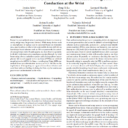
Jessica Sehrt, Feng Yi Lu, Leonard Husske, Anton Roesler, Valentin Schwind
WristConduct: Biometric User Authentication Using Bone Conduction at the Wrist Proceedings Article
In: Mensch und Computer 2022 (MuC '22), September 4-7, 2022, Darmstadt, Germany, ACM, New York, NY, USA, 2022, ISBN: 978-1-4503-9690-5/22/09.
@inproceedings{Sehrt2022a,
title = {WristConduct: Biometric User Authentication Using Bone Conduction at the Wrist},
author = {Jessica Sehrt and Feng Yi Lu and Leonard Husske and Anton Roesler and Valentin Schwind},
url = {https://dl.acm.org/doi/10.1145/3543758.3547542
https://vali.de/wp-content/uploads/2022/07/Muc2022-WristConduct.pdf},
doi = {10.1145/3543758.3547542},
isbn = {978-1-4503-9690-5/22/09},
year = {2022},
date = {2022-09-05},
urldate = {2022-09-05},
booktitle = {Mensch und Computer 2022 (MuC '22), September 4-7, 2022, Darmstadt, Germany},
publisher = {ACM},
address = {New York, NY, USA},
abstract = {Biometric user authentication is an important factor to ensure security and privacy for personal devices. While many devices such as smartphones or laptops can be unlocked based on biometric data, smartwatches or other wrist-worn mobile devices still rely on knowledge-based schemes such as PINs or passwords. In a proof-of-concept study with 24 participants, we show that it is possible to identify individuals using soundwaves passing through the wrist bones using a bone conduction speaker and a laryngophone (microphone). We tested support vector machines (SVMs) and artificial neural networks (ANNs) for binary classification. Using ANNs our method shows an authentication accuracy of 98.7%. We discuss the implications of integrating our approach into future devices and contribute with our findings in doing the first step for continuous passive user authentication at the wrist.},
keywords = {},
pubstate = {published},
tppubtype = {inproceedings}
}
2021
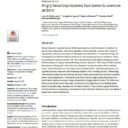
Leon O H Kroczek, Angelika Lingnau, Valentin Schwind, Christian Wolff, Andreas Mühlberger
Angry Facial Expressions Bias Towards Aversive Actions Journal Article
In: PLOS ONE, vol. 16, no. 9, pp. 1-13, 2021.
@article{10.1371/journal.pone.0256912,
title = {Angry Facial Expressions Bias Towards Aversive Actions},
author = {Leon O H Kroczek and Angelika Lingnau and Valentin Schwind and Christian Wolff and Andreas M\"{u}hlberger},
url = {https://doi.org/10.1371/journal.pone.0256912
https://vali.de/wp-content/uploads/2021/09/journal.pone_.0256912.pdf},
doi = {10.1371/journal.pone.0256912},
year = {2021},
date = {2021-01-01},
journal = {PLOS ONE},
volume = {16},
number = {9},
pages = {1-13},
publisher = {Public Library of Science},
abstract = {Social interaction requires fast and efficient processing of another person’s intentions. In face-to-face interactions, aversive or appetitive actions typically co-occur with emotional expressions, allowing an observer to anticipate action intentions. In the present study, we investigated the influence of facial emotions on the processing of action intentions. Thirty-two participants were presented with video clips showing virtual agents displaying a facial emotion (angry vs. happy) while performing an action (punch vs. fist-bump) directed towards the observer. During each trial, video clips stopped at varying durations of the unfolding action, and participants had to recognize the presented action. Naturally, participants’ recognition accuracy improved with increasing duration of the unfolding actions. Interestingly, while facial emotions did not influence accuracy, there was a significant influence on participants’ action judgements. Participants were more likely to judge a presented action as a punch when agents showed an angry compared to a happy facial emotion. This effect was more pronounced in short video clips, showing only the beginning of an unfolding action, than in long video clips, showing near-complete actions. These results suggest that facial emotions influence anticipatory processing of action intentions allowing for fast and adaptive responses in social interactions.},
keywords = {},
pubstate = {published},
tppubtype = {article}
}
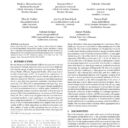
Dmitry Alexandrovsky, Susanne Putze, Valentin Schwind, Elisa D Mekler, Jan David Smeddinck, Denise Kahl, Antonio Krüger, Rainer Malaka
Evaluating User Experiences in Mixed Reality Workshop
CHI' 21 Association for Computing Machinery, Yokohama, Japan, 2021.
@workshop{10.1145/3411763.3441337,
title = {Evaluating User Experiences in Mixed Reality},
author = {Dmitry Alexandrovsky and Susanne Putze and Valentin Schwind and Elisa D Mekler and Jan David Smeddinck and Denise Kahl and Antonio Kr\"{u}ger and Rainer Malaka},
url = {https://doi.org/10.1145/3411763.3441337
https://vali.de/wp-content/uploads/2021/05/CHI2021-Workshop.pdf},
doi = {10.1145/3411763.3441337},
year = {2021},
date = {2021-05-07},
publisher = {Association for Computing Machinery},
address = {Yokohama, Japan},
series = {CHI' 21},
keywords = {},
pubstate = {published},
tppubtype = {workshop}
}
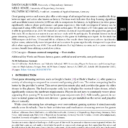
David Halbhuber, Niels Henze, Valentin Schwind
Increasing Player Performance and Gaming Experience in High Latency Setups Journal Article
In: Proceedings of the ACM on Human-Computer Interaction (CHIPLAY), vol. 5, no. 238, pp. 20, 2021.
@article{Halbhuber2021,
title = {Increasing Player Performance and Gaming Experience in High Latency Setups},
author = {David Halbhuber and Niels Henze and Valentin Schwind },
url = {https://doi.org/10.1145/3474710
https://vali.de/wp-content/uploads/2021/08/2021-CHIPLAY-Latency.pdf},
doi = {10.1145/3474710},
year = {2021},
date = {2021-09-01},
booktitle = {Proc. ACM Hum.-Comput. Interact. 5},
journal = {Proceedings of the ACM on Human-Computer Interaction (CHIPLAY)},
volume = {5},
number = {238},
pages = {20},
publisher = {Association for Computing Machinery},
abstract = {Cloud gaming services and remote play offer a wide range of advantages but can cause a considerable delay between input and action also known as latency. Previous work indicates that deep learning algorithms such as artificial neural networks (ANN) are able to compensate for latency. As high latency in video games significantly reduces player performance and game experience, this work investigates if latency can be compensated using ANNs within a live first-person action game. We developed a 3D video game and coupled it with the prediction of an ANN. We trained our network on data of 24 participants who played the game in a first study. We evaluated our system in a second user study with 96 participants. To simulate latency in cloud game streaming services, we added 180 ms latency to the game by buffering user inputs. In the study the ANN compensated 60 ms, 120 ms and 180 ms of latency. Our results show that players achieve significantly higher scores, substantially more hits per shot and associate the game significantly stronger with a positive affect when supported by our ANN. This work illustrates that high latency systems, such as game streaming services, benefit from utilizing a predictive system.},
keywords = {},
pubstate = {published},
tppubtype = {article}
}
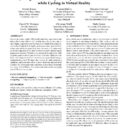
Martin Kocur, Florian Habler, Valentin Schwind, Paweł W Woźniak, Christian Wolf, Niels Henze
Physiological and Perceptual Responses to Athletic Avatars while Cycling in Virtual Reality Proceedings Article
In: Proceedings of the 2021 CHI Conference on Human Factors in Computing Systems, Association for Computing Machinery, Yokohama, Japan, 2021.
@inproceedings{10.1145/3411764.3445160,
title = {Physiological and Perceptual Responses to Athletic Avatars while Cycling in Virtual Reality},
author = {Martin Kocur and Florian Habler and Valentin Schwind and Pawe\l W Wo\'{z}niak and Christian Wolf and Niels Henze},
url = {https://doi.org/10.1145/3411764.3445160
https://vali.de/wp-content/uploads/2021/05/chi21-121.pdf},
doi = {10.1145/3411764.3445160},
year = {2021},
date = {2021-05-08},
booktitle = {Proceedings of the 2021 CHI Conference on Human Factors in Computing Systems},
publisher = {Association for Computing Machinery},
address = {Yokohama, Japan},
series = {CHI' 21},
keywords = {},
pubstate = {published},
tppubtype = {inproceedings}
}

Rufat Rzayev, Polina Ugnivenko, Sarah Graf, Valentin Schwind, Niels Henze
Reading in VR: The Effect of Text Presentation Type and Location Proceedings Article
In: Proceedings of the 2021 CHI Conference on Human Factors in Computing Systems, Association for Computing Machinery, Yokohama, Japan, 2021.
@inproceedings{10.1145/3411764.3445606,
title = {Reading in VR: The Effect of Text Presentation Type and Location},
author = {Rufat Rzayev and Polina Ugnivenko and Sarah Graf and Valentin Schwind and Niels Henze},
url = {https://doi.org/10.1145/3411764.3445606
https://vali.de/wp-content/uploads/2021/05/CHI2021-Reading-in-VR.pdf},
doi = {10.1145/3411763.3441337},
year = {2021},
date = {2021-05-08},
booktitle = {Proceedings of the 2021 CHI Conference on Human Factors in Computing Systems},
publisher = {Association for Computing Machinery},
address = {Yokohama, Japan},
series = {CHI' 21},
keywords = {},
pubstate = {published},
tppubtype = {inproceedings}
}
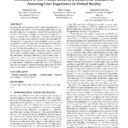
Martin Kocur, Niels Henze, Valentin Schwind
The Extent of the Proteus Effect as a Behavioral Measure for Assessing User Experience in Virtual Reality Proceedings Article
In: CHI 2021 - Workshop on Evaluating User Experiences in Mixed Reality, pp. 1–3, 2021.
@inproceedings{epub45543,
title = {The Extent of the Proteus Effect as a Behavioral Measure for Assessing User Experience in Virtual Reality},
author = {Martin Kocur and Niels Henze and Valentin Schwind},
url = {https://epub.uni-regensburg.de/45543/
https://vali.de/wp-content/uploads/2021/05/CHI2021-Workshop-ProteusEffectUX-1.pdf},
year = {2021},
date = {2021-01-01},
booktitle = {CHI 2021 - Workshop on Evaluating User Experiences in Mixed Reality},
pages = {1--3},
abstract = {Assessing the user experience (UX) while being immersed in a virtual environment (VE) is crucial to obtain insights about the quality and vividness of the experience created by virtual reality (VR) systems. These valuable insights are necessary to understand a user's response to VEs and, therefore, to advance in VR research. However, a standardized and effective measure for assessing UX is still missing. Consequently, this lack of suitable measures hinders researchers to gain knowledge and understanding about the effects of VEs on users and in turn slows down the progress in VR technology. To tackle this problem, we propose a behavioral measure for assessing UX based on a phenomenon known as the Proteus effect, which describes changes in behavior and attitude due to the embodiment of avatars with stereotypical characteristics. As avatars are a crucial part of an immersive experience, the extent of behavioral changes caused by the embodiment of avatars may pose an opportunity to implicitly quantify the UX of a VE. This paper discusses an alternative behavioral measure and contributes to the debate about suitable methods for assessing UX in VR systems.},
keywords = {},
pubstate = {published},
tppubtype = {inproceedings}
}
2020
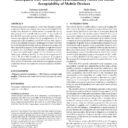
Valentin Schwind, Niels Henze
Anticipated User Stereotypes Systematically Affect the Social Acceptability of Mobile Devices Proceedings Article
In: Proceedings of the 11th Nordic Conference on Human-Computer Interaction: Shaping Experiences, Shaping Society, pp. 12, Association for Computing Machinery, Tallinn, Estonia, 2020, ISBN: 9781450375795.
@inproceedings{Schwind2020,
title = {Anticipated User Stereotypes Systematically Affect the Social Acceptability of Mobile Devices},
author = {Valentin Schwind and Niels Henze},
url = {https://doi.org/10.1145/3419249.3420113
https://vali.de/wp-content/uploads/2020/08/nordichi20-52.pdf},
doi = {10.1145/3419249.3420113},
isbn = {9781450375795},
year = {2020},
date = {2020-10-25},
booktitle = {Proceedings of the 11th Nordic Conference on Human-Computer Interaction: Shaping Experiences, Shaping Society},
pages = {12},
publisher = {Association for Computing Machinery},
address = {Tallinn, Estonia},
series = {NordiCHI ’20},
abstract = {Understanding social perception is crucial when designing socially accepted mobile devices. Using the stereotype content model (SCM), recent work showed that mobile devices systematically attract stereotypical users' warmth and competence. It was concluded that the SCM can predict a device's social acceptability. There is, however, no empirical evidence for the assumption that the SCM can predict social acceptability and it also unclear what causes a device's stereotypical perception. In this paper, we first verify that the SCM's dimensions strongly correlate with social acceptance and show that social acceptance can be explained through stereotypical perception. In a second study, we independently asked participants to assess the warmth and competence of mobile devices, human stereotypes, and the probability that human stereotypes use the devices. We found that warmth and competence of anticipated stereotypical users predict a device's position in the SCM. The combined results of both studies show that the stereotypical perception of anticipated users can explain the social acceptability of mobile devices.},
keywords = {},
pubstate = {published},
tppubtype = {inproceedings}
}

Francisco Kiss, Sven Mayer, Valentin Schwind
Audio VR: Did Video Kill the Radio Star? Journal Article
In: Interactions, vol. 27, no. 3, pp. 46–51, 2020, ISSN: 1072-5520.
@article{10.1145/3386385,
title = {Audio VR: Did Video Kill the Radio Star?},
author = {Francisco Kiss and Sven Mayer and Valentin Schwind},
url = {https://dl.acm.org/doi/abs/10.1145/3386385
https://vali.de/wp-content/uploads/2020/04/3386385.pdf},
doi = {10.1145/3386385},
issn = {1072-5520},
year = {2020},
date = {2020-01-01},
journal = {Interactions},
volume = {27},
number = {3},
pages = {46\textendash51},
publisher = {Association for Computing Machinery},
address = {New York, NY, USA},
keywords = {},
pubstate = {published},
tppubtype = {article}
}

Rufat Rzayev, Susanne Korbely, Milena Maul, Alina Schark, Valentin Schwind, Niels Henze
Effects of Position and Alignment of Notifications on AR Glasses during Social Interaction Proceedings Article
In: Proceedings of the 11th Nordic Conference on Human-Computer Interaction: Shaping Experiences, Shaping Society, Association for Computing Machinery, Tallinn, Estonia, 2020, ISBN: 9781450375795.
@inproceedings{10.1145/3419249.3420095,
title = {Effects of Position and Alignment of Notifications on AR Glasses during Social Interaction},
author = {Rufat Rzayev and Susanne Korbely and Milena Maul and Alina Schark and Valentin Schwind and Niels Henze},
url = {https://doi.org/10.1145/3419249.3420095
https://vali.de/wp-content/uploads/2020/10/rufatNordiCHI2020.pdf},
doi = {10.1145/3419249.3420095},
isbn = {9781450375795},
year = {2020},
date = {2020-01-01},
booktitle = {Proceedings of the 11th Nordic Conference on Human-Computer Interaction: Shaping Experiences, Shaping Society},
publisher = {Association for Computing Machinery},
address = {Tallinn, Estonia},
series = {NordiCHI '20},
abstract = {Notifications are one of the smartphones’ key features. However, notifications can be disruptive, especially during social interaction. Augmented reality (AR) glasses can embed notifications directly into the user’s field of view and enable reading them while being engaged in a primary task. However, for efficient notification presentation using AR glasses, it is necessary to understand how notifications should be displayed without negatively affecting social interaction. Therefore, we conducted a study with 32 participants (16 pairs) using AR glasses to investigate how to display notifications during face-to-face communication. We compared center and top-right positions for notifications while aligning them relative to the user’s field of view or with the conversation partner. We found significant effects of notification position and alignment on how notifications are perceived using AR glasses during face-to-face communication. Insights from our study inform the design of applications for AR glasses that support displaying digital notifications.},
keywords = {},
pubstate = {published},
tppubtype = {inproceedings}
}
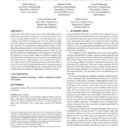
Rufat Rzayev, Sabrina Hartl, Vera Wittmann, Valentin Schwind, Niels Henze
Effects of Position of Real-Time Translation on AR Glasses Proceedings Article
In: Proceedings of the Conference on Mensch Und Computer, pp. 251–257, Association for Computing Machinery, Magdeburg, Germany, 2020, ISBN: 9781450375405.
@inproceedings{10.1145/3404983.3405523,
title = {Effects of Position of Real-Time Translation on AR Glasses},
author = {Rufat Rzayev and Sabrina Hartl and Vera Wittmann and Valentin Schwind and Niels Henze},
url = {https://doi.org/10.1145/3404983.3405523
https://vali.de/wp-content/uploads/2020/11/2020-MUC-HoloTranslate.pdf},
doi = {10.1145/3404983.3405523},
isbn = {9781450375405},
year = {2020},
date = {2020-01-01},
booktitle = {Proceedings of the Conference on Mensch Und Computer},
pages = {251\textendash257},
publisher = {Association for Computing Machinery},
address = {Magdeburg, Germany},
series = {MuC '20},
abstract = {Augmented reality (AR) provides users with contextually relevant multimedia content by overlaying it on real-world objects. However, overlaying virtual content on real-world objects can cause occlusion. Especially for learning use cases, the occlusion might result in missing real-world information important for learning gain. Therefore, it is important to understand how virtual content should be positioned relative to the related real-world information without negatively affecting the learning experience. Thus, we conducted a study with 12 participants using AR glasses to investigate the position of virtual content using a vocabulary learning task. Participants learned foreign words shown in the surrounding while viewing translations using AR glasses as an overlay, on the right or below the foreign word. We found that showing virtual translations on top of foreign words significantly decreases comprehension and increase users' task load. Insights from our study inform the design of applications for AR glasses supporting vocabulary learning.},
keywords = {},
pubstate = {published},
tppubtype = {inproceedings}
}
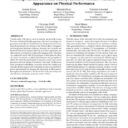
Martin Kocur, Melanie Kloss, Valentin Schwind, Christian Wolff, Niels Henze
Flexing Muscles in Virtual Reality: Effects of Avatars' Muscular Appearance on Physical Performance Proceedings Article
In: Proceedings of the Annual Symposium on Computer-Human Interaction in Play, pp. 193–205, Association for Computing Machinery, Virtual Event, Canada, 2020, ISBN: 9781450380744.
@inproceedings{10.1145/3410404.3414261,
title = {Flexing Muscles in Virtual Reality: Effects of Avatars' Muscular Appearance on Physical Performance},
author = {Martin Kocur and Melanie Kloss and Valentin Schwind and Christian Wolff and Niels Henze},
url = {https://doi.org/10.1145/3410404.3414261
https://vali.de/wp-content/uploads/2020/11/2020-CHIPLAY-PowerVR.pdf},
doi = {10.1145/3410404.3414261},
isbn = {9781450380744},
year = {2020},
date = {2020-01-01},
booktitle = {Proceedings of the Annual Symposium on Computer-Human Interaction in Play},
pages = {193\textendash205},
publisher = {Association for Computing Machinery},
address = {Virtual Event, Canada},
series = {CHI PLAY '20},
abstract = {Virtual reality (VR) allows users to embody any possible avatar. Previous work found that the appearance of avatars can change our perception and behavior. Such behavioral changes based on stereotypical assessments are known as the Proteus effect. Exergames involve physical activities of players, however, it is currently unknown if behavioral changes caused by an avatar's appearance can affect players' performance in physically engaging tasks. Therefore, we conducted a study with 30 participants to determine the effect of avatars' muscularity on physical performance and perception of effort. We found that participants in muscular avatars had a lower perceived exertion during an isometric force task. Furthermore, male participants embodying a muscular avatar had a higher grip strength. Results suggest that embodying avatars associated with power and strength can decrease the perception of effort and enhance physical performance. We discuss how body ownership, user identification, and gender moderate avatars' effects.},
keywords = {},
pubstate = {published},
tppubtype = {inproceedings}
}

Anna-Marie Ortloff, Maximiliane Windl, Valentin Schwind, Niels Henze
Implementation and In Situ Assessment of Contextual Privacy Policies Proceedings Article
In: Proceedings of the 2020 on Designing Interactive Systems Conference, pp. 14, Association for Computing Machinery, Eindhoven, Netherlands, 2020, ISBN: 9781450369749.
@inproceedings{Ortloff2020,
title = {Implementation and In Situ Assessment of Contextual Privacy Policies},
author = {Anna-Marie Ortloff and Maximiliane Windl and Valentin Schwind and Niels Henze},
url = {https://dx.doi.org/10.1145/3357236.3395549
https://vali.de/wp-content/uploads/2020/05/CPP_camera_ready.pdf},
doi = {10.1145/3357236.3395549},
isbn = {9781450369749},
year = {2020},
date = {2020-07-06},
booktitle = {Proceedings of the 2020 on Designing Interactive Systems Conference},
pages = {14},
publisher = {Association for Computing Machinery},
address = {Eindhoven, Netherlands},
series = {DIS ’20},
abstract = {Online services collect an increasing amount of data about their users. Privacy policies are currently the only common way to inform users about the kinds of data collected, stored and processed by online services. Previous work showed that users do not read and understand privacy policies, due to their length, difficult language, and often non-prominent location. Embedding privacy-relevant information directly in the context of use could help users understand the privacy implications of using online services. We implemented Contextual Privacy Policies (CPPs) as a browser extension and provide it to the community to make privacy information accessible for end-users. We evaluated CPPs through a one-week deployment and in situ questionnaires as well as pre- and post-study interviews. We found that CPPs were well received by participants. The analysis revealed that provided information should be as compact as possible, be adjusted to user groups and enable users to take action.},
keywords = {},
pubstate = {published},
tppubtype = {inproceedings}
}
Chairs/Committee
- CHI Symposium on Human-Computer Interaction (Associate Chair)
- CHI PLAY Symposium on Human-Computer Interaction in Play (Associate Chair)
- INTERACT Int. Conference on Human-Computer Interaction (Associate Chair)
- MUC Mensch und Computer 2017 (Program Committee)
- VRST Symposium on Virtual Reality Software and Technology (2017, Publicity Chair)
Reviewer
- CHI SIGCHI Conference on Human Factors in Computing Systems
- SIGGRAPH SIGGRAPH Conference on Computer Graphics & Interactive Techniques
- NATURE Springer Nature Scientific Reports
- AH Augmented Humans International Conference
- IEEE VR IEEE Conference on Virtual Reality and 3D User Interfaces
- MobileHCI ACM Int. Conference on Human-Computer Interaction with Mobile Devices and Services
- IJHCI Int. Journal of Human-Computer Interaction
- ISMAR Int. Symposium on Mixed and Augmented Reality
- EICS ACM SIGCHI Symposium on Engineering Interactive Computing Systems
- TEI Int. Conference on Tangible, Embedded, and Embodied Interactions
- VRST Symposium on Virtual Reality Software and Technology
- CHI PLAY Symposium on Human-Computer Interaction in Play
- IJHCS International Journal of Human-Computer Studies
- IMWUT Proceedings of the ACM on Interactive, Mobile, Wearable and Ubiquitous Technologies
- ACMMM ACM Multimedia Conference
- MUM International Conference on Mobile and Ubiquitous Multimedia
- MUC Mensch und Computer
In Press
- SPIEGEL ONLINE about faceMaker
- WELT/N24 about faceMaker
- HEISE ONLINE about faceMaker
- HEISE ONLINE about our Computer Mouse event with Rainer Mallebrein
- STUTTGARTER ZEITUNG about faceMaker
- STUTTGARTER NACHRICHTEN about faceMaker
- SÜDWEST PRESSE about faceMaker